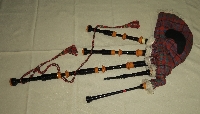Bagpipes - don't you just love 'em? Or perhaps, hate 'em?
Properly tuned and played - preferably in a suitably romantic location, such as a hillside looking over to one of these far-flung Western Isles - they sound absolutely magical. Unfortunately, they can also sound horrible, for many different reasons, some of which I explore in the Tuning section.
The focus of this website is the Great Highland Bagpipe - ie, the familiar variety which every Scot or visitor to Scotland understands as "bagpipes" (consisting of a bag, a blowstick, a chanter and three drones). The tartan cover is now considered rather old-fashioned. But as can be seen in the picture above, the Great Highland Bagpipe is not the only version of this instrument. Nor is it the most sophisticated (that accolade must surely go to the wonderful Uillean pipes of the Emerald Isle).
This site covers all aspects of my bagpiping journey. There are several strands to this story, including tuning, music (learned, performed and listened to) people and events.
Tuning the Pipes
For most of my bagpiping journey, from when I started playing the pipes at the age of around 14, until the last few years, the subject of tuning was, as Winston Churchill said of the Soviet Union in 1939, "a riddle wrapped in a mystery inside an enigma". I knew only that:
- the high- and low-A on the chanter should sound an octave apart (something that could be arranged by lowering or raising the chanter reed in its socket); and
- the tenor and bass drones should sound one and two octaves below the low-A respectively (which could be brought about by changing the lengths of the drones).
I did not know about "balancing" chanters with tape until I started attending the National Piping Centre Summer Schools in 2005. Until the advent of electronic tuners, the correct relationships of the notes could only be established by listening: as long as you had an educated musical ear (which I fear, I did not). I did my best but the mystery for me lay in understanding how the chanter's notes should sound in relation to each other. Or, more particularly, how they could be adjusted in order to produce a perfectly harmonious sound.
As with any musical instrument that has a large number of enthusiastic players, there is a multitude of sources of information about bagpipes.
(Everything on this page is "to Follow!")
Books (including Tutors)
I have very few books about bagpiping - all rather lacking in detail about history and theory - but a quick search of Amazon or the British Library catalogue reveals that there is no shortage of scholarly treatises on the Great Highland Bagpipe and other varieties of this genre of instrument.
Periodicals
Some of these have come and gone but even those which have "ceased to be" can have useful articles (if you can find them on-line or in archives).
Handouts
A few of the pages given out during courses have proved to be useful.
Websites
There are a lot of websites offering advice on musical theory pertaining to the bagpipes.
Some, listed below, have been invaluable to me in developing my understanding of bagpipe tuning.
Museums
Newcastle
Pitt Rivers
Organisations
The following list is limited to the UK. There are many regional societies in other countries devoted to the GHB and other forms of piping.
The Bagpipe Society
College of Piping
National Piping Centre
Double Reed Society
Conferences
I have only attended one such event - organised by the Piping Society in London in 2012.



